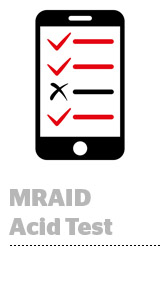 The Interactive Advertising Bureau (IAB) wants to help advertisers manage their quality assurance testing for mobile rich media ads.
The Interactive Advertising Bureau (IAB) wants to help advertisers manage their quality assurance testing for mobile rich media ads.
On Monday, the IAB Tech Lab released the MRAID Ads SDK Tester app at its at Annual Leadership Meeting in Palm Desert, Calif. The app is a free open-source tool designed to validate the functionality of in-app ads against multiple software development kits (SDKs) simultaneously.
The purpose is to make it easier for members of the supply chain to comply with MRAID, the IAB’s standard for rendering and serving mobile rich media programmatically.
The idea behind MRAID is to create a common protocol for mobile ad formats so that the same creative behaves the same way across various apps and operating systems. It’s a standardized set of commands to ensure that an ad designed to access a device’s accelerometer, for example, or play a video can use the same code regardless of where the ad is running.
But the way it works today, if advertisers or developers work with multiple monetization partners, they have to test the compatibility of their in-app ad creative against each partner’s SDK. A rich-media vendor might say its SDK is built for standard delivery even though it isn’t, and that creates headaches for developers and ad ops people down the line.
Ensuring that every piece of creative is kosher from an MRAID perspective can be a time-consuming process, said Scott Cunningham, general manager of the IAB’s Tech Lab.
“As a developer or an ops person building solutions, you need to do one-off testing all the time,” Cunningham said. “Our standards are often written in PDFs and people deploy them differently. This is a tool to enable the standards and protocol we release to actually be followed.”
It works like this: Rather than testing one ad multiple times against each SDK environment, designers, developers, publishers and ad ops types who download the MRAID tester app can drop their tags into an interface that concurrently checks the functionality of mobile rich-media ads across numerous SDKs before they actively run in major mobile apps.
The tool also functions on desktop – where ad ops teams are more likely to spend the bulk of their day trafficking ads – through iOS and Android emulators.
“People will often create ad units and then get too far down the path before they realize those units are not compatible with the standard, and then they have to go back upstream and make changes,” Cunningham said. “We’re trying to eliminate some of that friction, labor and overhead and help with the workflow.”
The hope is that removing some of that frustration will create more rich-media demand and increase fill rates and CPMs for the publisher community.
AdExchanger Daily
Get our editors’ roundup delivered to your inbox every weekday.
Daily Roundup
“This should increase confidence in correct MRAID ad creation which should further boost the use of MRAID in the mobile ad ecosystem,” said Adam Schuetz, senior director of engineering at Opera Mediaworks. “This is especially critical as more mobile ad trafficking is happening via programmatic exchanges.”
For the moment, there are four ad networks participating in the project – Millennial Media, AdMarvel (which Opera Mediaworks acquired in 2010), PubMatic and InMobi. The plan is to expand the MRAID tester’s reach and efficacy with the addition of more SDK partners throughout the year.
The IAB Tech Lab is getting serious about making it easier for members of the supply chain to adhere to its standards. In addition to the MRAID tool, the lab is also working with IAB members to developer an HTML5 validator and an OpenRTB testing tool.
The MRAID Ads SDK Tester is generally available for download in the App Store, via Google Play and through the IAB’s site.













